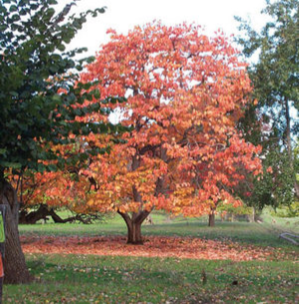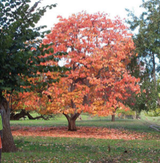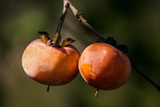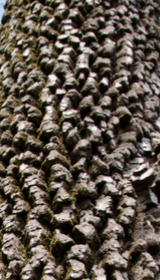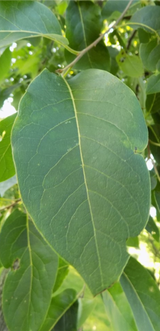- 2024 Native Trees
- >
- Native Trees
- >
- PERSIMMON (Diospyros virginiana)
PERSIMMON (Diospyros virginiana)
Height: 30 to 50 feet
Spread: 25 to 35 feet
Bloom Time: May to June
Bloom Description: White to Green Yellow
Sun: Full Sun to Part Shade
Suggested Use: Wildlife/ Fruit
Tolerate: Strip Mine Ground, Drought, Clay Soils, Black Walnut
Attracts: Butterflies & Honey Bees
Native to: Jefferson County
A native fruit tree that rewards the patient and teaches the impatient.
The Spanish Conquistador Hernando de Soto while trekking up the Mississippi Valley (ironically not in his Chrysler DeSoto) first documented and praised the persimmon in 1539. However, it was Captain John Smith, who after being saved by Pocahontas became transfixed by the fruit and best described the persimmon when he wrote: “ If it be not ripe, it will draw a man’s mouth awrie with much torment.” A description that so well describes the fruit that is quite astringent when green, but upon ripening becomes sweet and may be eaten off the tree. An old wives tale says that fruit should not be consumed until they are kissed by frost.
Persimmon trees are a hardy tree that grow well under hostile conditions. Since de Soto’s time the tree has been a lightning rod for criticism and love. Those who have favor the tree and its fruit feel the tree will one day take its rightful place in the Pantheon of native fruits and be accorded a place in every orchard and garden. Whereas, those who have bit into the immature fruit or dealt with its suckering habits have puckered their face to the point of which to see the tree eradicated from the landscape.
The tree has a rounded growth habit and is very easily grown with a tendency to create suckers to colonize areas. Persimmon has a distinctive dark gray bark that is broken into rectangular blocks. Leaves are a glossy green and oval in shape about 4-6” in size. Flowers are white to greenish-yellow in color with male flowers appearing in clusters and female flowers being solitary. The Fruit is orange to reddish purple in color and appear in late fall and are about 1-2 inches in diameter. Fruits are typically used in jellies, pies, syrups and ice cream. The tree is in the ebony wood family and the wood has been used for golf clubs and billiard cues. The Persimmon is a dioecious species with separate male and female plants. Only the females produce fruit. The trees offered in the Jefferson Soil and Water Conservation District Native Plant Sale are unsexed trees, so it is recommended to buy multiple trees.
The tree is a host plant for 46 species of butterflies and moths and attracts 12 different genera of birds. The tree is also an important symbiotic pollinator plant for native and honey bees.■

